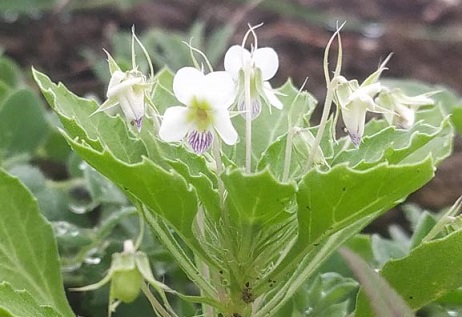Flavonoid glycosides from the herb Viola Stocksii shows promising therapeutic properties against SARS-CoV-2 variants
Nikhil Prasad Fact checked by:Thailand Medical News Team Sep 15, 2024 7 months, 16 hours, 3 minutes ago
Herbs And Phytochemicals: The battle against COVID-19 has seen a myriad of medical and natural approaches emerge, with one lesser-known but potent player being Viola stocksii, a plant traditionally used in parts of South Asia for respiratory and digestive ailments. Researchers have recently explored the plant’s potential as a source of antioxidant and anti-inflammatory compounds that could play a role in mitigating the effects of COVID-19. This
Herbs And Phytochemical news report will delve into the key findings of this study.
 Flavonoid glycosides from the herb Viola Stocksii shows promising therapeutic properties against SARS-CoV-2 variants
Key Bioactive Components of Viola Stocksii
Flavonoid glycosides from the herb Viola Stocksii shows promising therapeutic properties against SARS-CoV-2 variants
Key Bioactive Components of Viola Stocksii
The study, which involved comprehensive analysis of Viola stocksii, focused on identifying its bioactive compounds, particularly flavonoid glycosides. These are known for their antioxidant and anti-inflammatory properties. The researchers found that the plant contains significant amounts of kaempferol and quercetin derivatives, both of which have shown strong potential in neutralizing free radicals and reducing inflammation. The study outlines how these flavonoid glycosides target SARS-CoV-2 and its variants, making the plant a noteworthy candidate for COVID-19 treatment.
Viola stocksii is a small herb that has long been used in traditional medicine in South Asia. The locals often prepare tea from the plant to alleviate symptoms like coughing, fever, and digestive issues. However, during the COVID-19 pandemic, the demand for natural remedies increased, and Viola stocksii became popular for its purported respiratory benefits.
Study Methodology and Findings
The study employed a range of chromatographic techniques, including RP-HPLC and NMR analysis, to isolate and identify the bioactive flavonoid glycosides in Viola stocksii. Four compounds were identified: apigenin 6,8-di-C-α-L-arabinopyranoside (Api6,8-di-αArb), apigenin 6-C-α-L-arabinopyranosyl-8-C-β-L-arabinopyranoside (Api6-α,8-βArb), quercetin-3-O-rutinoside (QurGluαRh), and kaempferol-3-O-rutinoside (KamGluαRh). In preliminary in vitro studies, these compounds demonstrated significant antioxidant, anti-inflammatory, and immunomodulatory activities.
The researchers also conducted in silico studies to evaluate the compounds’ binding affinities to critical SARS-CoV-2 proteins such as the main protease (MPro), the spike trimer, and surface glycoproteins. Both quercetin and kaempferol derivatives exhibited strong binding affinities with the MPro enzyme and spike trimer, which are crucial for viral replication and entry into human cells.
Binding Affinity and Therapeutic Potential
The in-silico analysis revealed that kaempferol (KamGluαRh) and quercetin (QurGluαRh) had the highest binding affinities among the isolated compounds, with values ranging between -10 and -13 kcal/mol. These flavonoids showed s
trong interactions with the receptor-binding domain (RBD) of the spike protein, which is a hotspot for mutations in SARS-CoV-2 variants. This suggests that the compounds may help inhibit viral entry into human cells.
Molecular docking studies further validated the therapeutic potential of these compounds. Both KamGluαRh and QurGluαRh demonstrated stable interactions with the MPro enzyme, a key player in the coronavirus life cycle. The study noted that these compounds could prevent the virus from replicating by inhibiting MPro, thus limiting the spread of the virus within the host.
Antioxidant and Anti-inflammatory Benefits
One of the most compelling aspects of Viola stocksii is its high antioxidant capacity. The study found that the plant’s polar fractions, particularly the butanol and water-soluble extracts, had impressive free radical scavenging abilities. These extracts were effective in both DPPH and ABTS assays, with IC50 values as low as 0.03 μg/ml. The ability of Viola stocksii to combat oxidative stress is crucial, as oxidative damage plays a significant role in the progression of COVID-19.
In addition to its antioxidant properties, the plant exhibited strong anti-inflammatory effects. The flavonoid glycosides were tested for their ability to inhibit pro-inflammatory enzymes, and quercetin-3-O-rutinoside (QurGluαRh) was found to be particularly potent. With an IC50 value of 5.43 μg/ml, this compound could help reduce the hyperinflammatory response often seen in severe COVID-19 cases.
Immunomodulatory Effects
The study also highlighted the immunomodulatory potential of Viola stocksii. Flavonoid glycosides like quercetin and kaempferol are known to regulate immune responses by influencing cytokine production and modulating immune cell proliferation. This could make Viola stocksii a valuable tool in managing not only COVID-19 but also other viral respiratory infections.
Potential Applications and Conclusions
While more research is needed to confirm these findings in clinical settings, the study positions Viola stocksii as a promising natural remedy for combating COVID-19 and its variants. The plant’s antioxidant, anti-inflammatory, and immunomodulatory properties, combined with its ability to inhibit key viral proteins, suggest that it could be developed into an effective therapeutic or supplement.
In conclusion, Viola stocksii offers a multi-faceted approach to tackling COVID-19, addressing viral replication, inflammation, and immune responses. Its bioactive flavonoid glycosides, particularly quercetin and kaempferol derivatives, show strong potential as antiviral agents. With further research, this humble plant could become a key player in the fight against COVID-19, particularly in areas with limited access to conventional medicine. The study’s findings offer hope that nature’s remedies, like Viola stocksii, may hold the key to overcoming this global pandemic.
The findings of this study were published in the peer-reviewed journal: Food Bioscience.
https://www.sciencedirect.com/science/article/pii/S2212429224015256
For the latest on Herbs And Phytochemicals, keep on logging to Thailand
Medical News.
Read Also:
https://www.thailandmedical.news/news/malaysian-researchers-discover-marantodes-pumilum-extract-as-a-potential-therapeutic-against-covid-19
https://www.thailandmedical.news/news/the-phytochemical-oleandrin-shows-promise-in-combating-both-cancer-and-covid-19-by-targeting-grp78
https://www.thailandmedical.news/articles/herbs-and-phytochemicals
